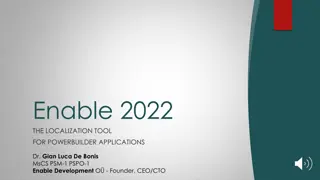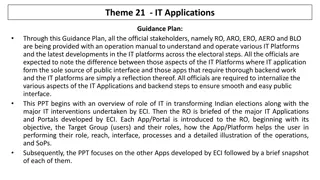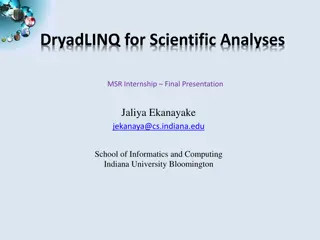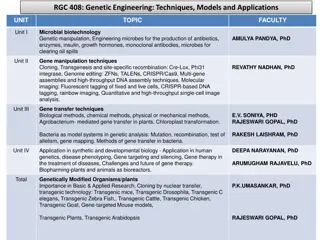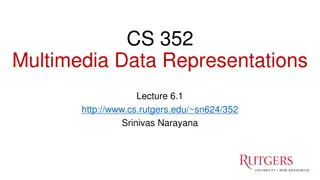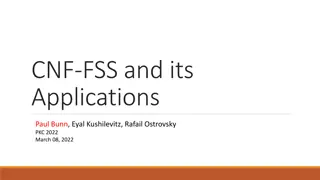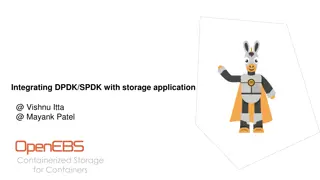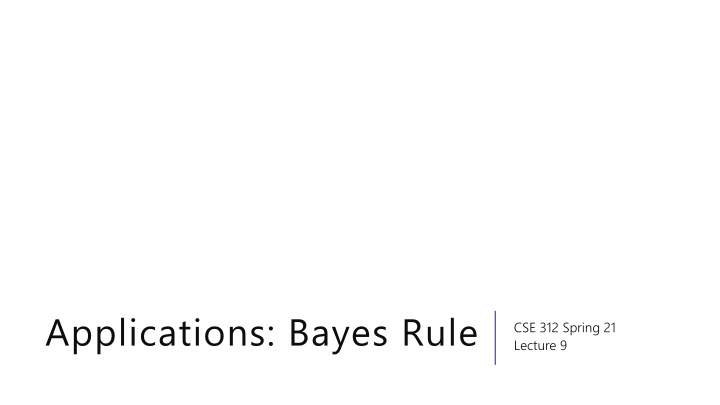
Bayes Rule in Real-World Applications
Explore the practical application of Bayes Rule in medical tests, helping doctors and patients understand health statistics. Learn how doctors improved accuracy using a simple calculation trick. Understand the significance of Bayes Rule in routine medical tests in the real world.
Download Presentation

Please find below an Image/Link to download the presentation.
The content on the website is provided AS IS for your information and personal use only. It may not be sold, licensed, or shared on other websites without obtaining consent from the author. If you encounter any issues during the download, it is possible that the publisher has removed the file from their server.
You are allowed to download the files provided on this website for personal or commercial use, subject to the condition that they are used lawfully. All files are the property of their respective owners.
The content on the website is provided AS IS for your information and personal use only. It may not be sold, licensed, or shared on other websites without obtaining consent from the author.
E N D
Presentation Transcript
Applications: Bayes Rule CSE 312 Spring 21 Lecture 9
Announcements First real-world mini-project comes out tonight. Due in 2 weeks. Goal is to give you a chance to think about why what you re learning matters in the real world.
Today Bayes Rule in the real world!
Application 1: Medical Tests Helping Doctors and Patients Make Sense of Health Statistics A researcher posed the following scenario to a group of 160 doctors: Assume you conduct a disease screening using a standard test in a certain region. You know the following information about the people in this region: The probability that a person has the disease is 1% (prevalence) If a person has the disease, the probability that she tests positive is 90% (sensitivity) If a person does not have the disease, the probability that she nevertheless tests positive is 9% (false-positive rate) A person tests positive. She wants to know from you whether that means that she has the disease for sure, or what the chances are. What is the best answer? A. The probability that she has the disease is about 81%. B. Out of 10 people with a positive test, about 9 have the disease. C. Out of 10 people with a positive test, about 1 have the disease. D. The probability that she has the disease is about 1%
Lets do the calculation! Let ?be the patient has the disease , ? be the test was positive. ? ? = ? ? ? / (?) = .99 .09+ .01 .9 0.092 .9 .01 Calculation tip: for Bayes Rule, you should see one of the terms on the bottom exactly match your numerator (if you re using the LTP to calculate the probability on the bottom)
How did the doctors do C (about 1 in 10) was the correct answer. Of the doctors surveyed, less than got it right (so worse than random guessing and worse than the class did on the polleverywhere last week). After the researcher taught them his calculation trick, more than 80% got it right.
One Weird Trick! Calculation Trick: imagine you have a large population (not one person) and ask how many there are of false/true positives/negatives.
What about the real world? When you re older and have to do more routine medical tests, don t get concerned (yet) when they ask to run another test.* It s usually fine.* *This is not medical advice, Robbie is not a physician.
No More Medical Testing Examples We re living in a pandemic We re not going to use COVID for any examples (Robbie is too tired of seeing bad takes on twitter) If you want to think about COVID and Bayes Rule, you ll be able to on the real world assignment coming out today.
Bayes Factor Another Intuition Trick: from 3Blue1Brown from 3Blue1Brown When you test positive, you (approximately Bayes Factor (aka likelihood ratio) approximately) multiply the prior by the sensitivity false positive rate=1 ??? ???
Bayes Factor Does it work? Let s try it Find prior Sensitivity ???
Wonka Bars Willy Wonka has placed golden tickets on 0.1% of his Wonka Bars. You want to get a golden ticket. You could buy a 1000-or-so of the bars until you find one, but that s expensive you ve got a better idea! You have a test a very precise scale you ve bought. If the bar you weigh does does have a golden ticket, the scale will alert you 99.9% of the time. If the bar you weigh does not have a golden ticket, the scale will (falsely) alert you only 1% of the time. If you pick up a bar and it alerts, what is the probability you have a golden ticket?
Wonka Bars Bayes Factor 99.9 1 Prior: .1% Product: 9.99, so about 10% About what Bayes Rule gets!
Application 1: Medical Tests Helping Doctors and Patients Make Sense of Health Statistics A researcher posed the following scenario to a group of 160 doctors: Assume you conduct a disease screening using a standard test in a certain region. You know the following information about the people in this region: The probability that a person has the disease is 1% (prevalence) If a person has the disease, the probability that she tests positive is 90% (sensitivity) If a person does not have the disease, the probability that she nevertheless tests positive is 9% (false-positive rate) A person tests positive. She wants to know from you whether that means that she has the disease for sure, or what the chances are. What is the best answer? A. The probability that she has the disease is about 81%. B. Out of 10 people with a positive test, about 9 have the disease. C. Out of 10 people with a positive test, about 1 have the disease. D. The probability that she has the disease is about 1%
Bayes Factor What about with the doctors? 1% 90% 9%= 10% Again about right!
Caution Multiplying by the Bayes Factor is an approximation It gives you the exact numerator for Bayes, but the denominator is the number of false positives if the prevalence (/prior) were 0 approximation When the prior is close to 0, this is a fine approximation! But plug in a prior of 15% on the last slide, and we get 150% chance.
What about negative tests? For negative tests, the Bayes Factor is ??? Sensitivity (false negative rate)
Application 2: An Imbalanced Survey In 2014, a paper was published Do non-citizens vote in U.S. elections? This is a real paper (peer-reviewed). It claims that 1. In a survey, about 4% (of a few hundred) of non-U.S.-citizens surveyed said they voted in the 2008 federal election (which isn t allowed). 2. Those non-citizen voters voted heavily (estimate 80+%) for democrats. 3. It is likely though by no means certain that John McCain would have won North Carolina were it not for the votes for Obama cast by non-citizens
Application 2: What is this survey? The Cooperative Congressional Election Study was run in 2008 and 2010. It interviews about 20,000 people about how/whether they voted in federal elections. Two strange observations: 1. The noncitizens are a very small portion of those surveyed. Feels a little strange. 2. Those people maybe accidentally admitted to a crime?
Application 2: Another Red Flag A response paper (by different authors) The perils of cherry picking low frequency events in large sample surveys
An Explanation Suppose 0.1% of people check the wrong check-box on any individual question (independently) Suppose you really interviewed 20,000 people, of whom 300 are really non-citizens (none of whom voted), and the rest are citizens, of whom 70% voted. What is the probability someone appears to have voted ??? ?? ??? ? (??? ?) (??? ??) .001 .7 300 20000)+.001 (19700 ??? ? ??? ?? = = 20000) .999 ( 4.38%
Conclusion The authors of the original paper did know about response error and they have an appendix that argues the population of non-citizen voters isn t distributed exactly like you d expect. But with it being such a small number of people, this isn t surprising. And even they admit response bias played more of a role than they initially thought. Though they still think they found some evidence of non-citizens voting (but not enough to flip North Carolina anymore).


![READ⚡[PDF]✔ Solar Sailing: Technology, Dynamics and Mission Applications (Spring](/thumb/21622/read-pdf-solar-sailing-technology-dynamics-and-mission-applications-spring.jpg)


